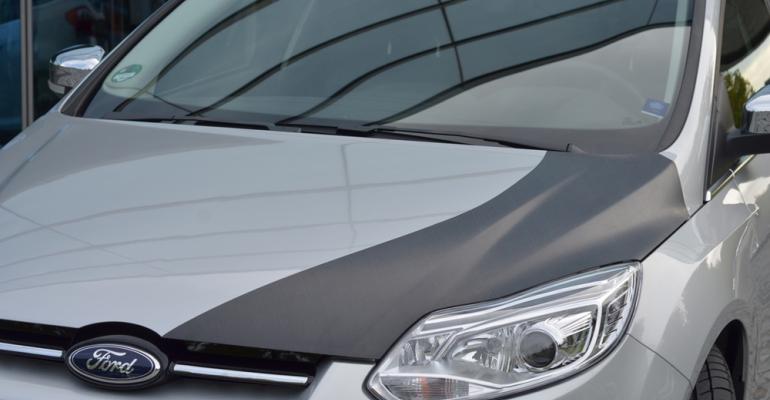Ford unveils a prototype carbon-fiber-reinforced plastic hood that is 50% lighter than a standard steel part and could help lower fuel consumption.
The Ford Focus hood displayed at a Composites Europe event in Dusseldorf, Germany, is constructed from the super-strong material usually associated more with hand-built racing vehicles or high-performance super cars.
However BMW last year said was looking to recruit 40 engineers with carbon-fiber expertise to help meet its goal of launching its i3 and i8 small, lightweight electrified vehicles in 2013.
The auto maker also formed a joint venture with German carbon-fiber producer SGL Group. Its subsidiary, SGL-Automotive Carbon Fiber, in Moss Lake, WA, is producing the fibers, the rovings made with 50,000 fibers and the unwoven cloth used to make parts.
The U.S. plant began production in third-quarter 2011. BMW said it would make the body parts, itself, with tools and processes it had designed.
Ford says production time for an individual carbon-fiber hood is fast enough to be employed on a high-volume production line, which is says is a significant step towards using more lightweight materials.
Initial testing suggests CFRP components such as the prototype Focus hood will meet Ford’s high standards for stiffness, dent resistance and crash performance, the auto maker says in a statement.
“The component has also performed well in pedestrian-protection head-impact tests, thanks to its innovative construction of a special foam core sandwiched between two layers of CFRP.”
However, Ford says the techniques that have been refined and developed for the prototype hood will not be seen in production in the near future, but could be transferred to higher-volume applications at a later date.
Ford, along with European suppliers Henkel, Evonik, Toho Tenax and Composite Impulse, has joined with specialists from the Institute of Automotive Engineering at RWTH Aachen University and the IKV (Institute of Plastics Processing to participate in what is called the Hightech.NRW research project.
Funded by the German state of North Rhine-Westphalia, the project began in 2010 and is set to continue until September 2013.
The high-tech NRW research project aims to:
- Develop a cost-effective method to manufacture carbon-fiber composites for body-panel applications that can be incorporated into existing vehicle-production processes.
- Significantly reduce individual component production times.
- Reduce the amount of finishing work required.
- Meet requirements for painting.
- Reduce component weight by at least 50%.
The involvement of the Ford European Research Center in the project follows Ford’s partnership with Dow Automotive Systems, a collaboration announced earlier this year that will investigate new materials, design processes and manufacturing techniques.
Dow and Ford are working to establish an economical source of automotive-grade carbon fiber as well as create high-volume manufacturing methods.
“Reducing a vehicle’s weight can deliver major benefits for fuel consumption, but a process for fast and affordable production of carbon-fiber automotive parts in large numbers has never been available,” says Inga Wehmeyer, advanced materials and processes research engineer at the Ford European Research Center.
“By partnering with materials experts through the Hightech.NRW research project, Ford is working to develop a solution that supports cost-efficient manufacturing of carbon-fiber components.”
Carbon fiber offers a high strength-to-weight ratio. It is up to five times as strong as steel, twice as stiff and one-third the weight.
Ford says advanced materials such as carbon fiber are key in reducing the weight of its cars up to 750 lbs (340 kg) by the end of the decade.
“There are two ways to reduce energy use in vehicles: improving the conversion efficiency of fuels to motion and reducing the amount of work that powertrains need to do,” says Paul Mascarenas, the auto maker’s chief technical officer and vice president-research and innovation.
“Ford is tackling the conversion problem primarily through downsizing engines with EcoBoost and electrification, while weight reduction and improved aerodynamics help to reduce the workload.”




